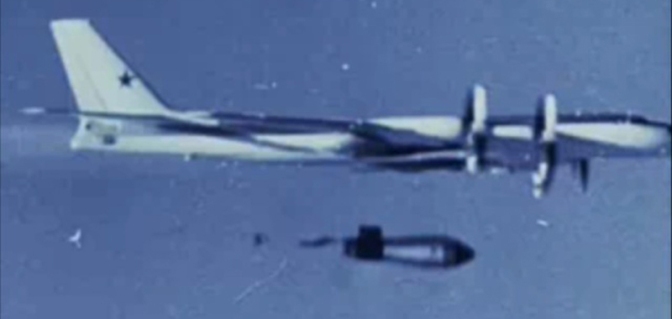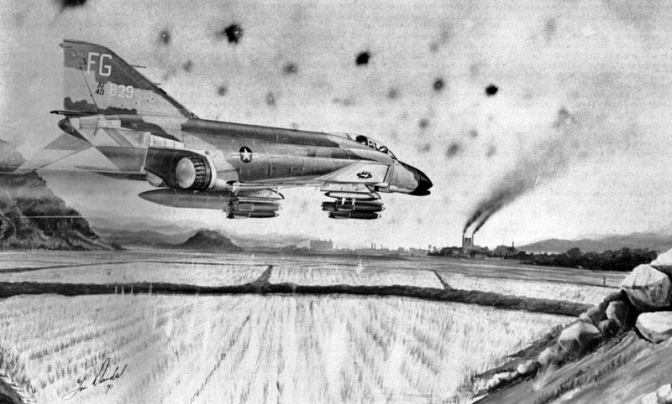By Tom Demerly for ALERT 5.

29 December, 1966. SAC Chrome Dome II Patrol Route, Flight Level 370 over Queen Elizabeth Islands, 631 miles inside the Arctic Circle.
Their bellies bloated with nuclear tipped mega-death, the Valkyries ride tails of afterburner flame on a Mach 3 stampede to incinerate the Red Menace before they can launch.
WWIII has started.
1-hour and 56 minutes ago a complex encounter between a Russian submarine and a U.S. aircraft carrier off the Cuban coast turned into a simple act of war. The Russians launched. The U.S. has countered. The nuclear trigger is squeezed past the breaking point.
Three Strategic Air Command B-70 Valkyrie bombers are already in the air on routine Airborne Global Alert status near the Arctic Circle when the launch code is issued and authenticated. The crews in the cockpits turn silent and serious. Upon hearing the attack command, one crewmember losses his bowels and sits in a putrid mush inside his flight suit. The huge bombers climb to attack altitude and light their afterburners, lowering their wingtips like a swooping bird of prey to ride their own shockwaves. The B-70’s turn left and north from their patrol orbits to cross almost directly over the North Pole and hurtle across the Siberian wasteland at Mach 3. They will hit the Russian airfields and ICBM bases that pose the most immediate threat to the United States.

There is no doubt the Reds will get some bombers and missiles off, and that some of them will find their targets in the U.S. But this is a lethal game of numbers: destroy as many Soviet warheads on the ground as possible before they get in the air. Lose as few U.S. cities as possible. Save as many American schoolchildren doing their “Duck! And Cover!” drills in classrooms and fallout shelters as they can.
Fueled by fear and the specter of “Mutually Assured Destruction” America’s nuclear trigger finger has been itchy ever since General Curtis LeMay launched the first nuclear strikes on Hiroshima and Nagasaki in WWII.
Adding to the secret legacy of fear about “maintaining our first strike capability” was the discovery of Nazi secret weapons facilities at Peenemunde, Germany toward the end of WWII. The Germans were working on a crude ICBM, a two-stage V-2 ballistic missile with enough range to hit Manhattan. German scientists also had a top-secret rudimentary nuclear weapons program.

The Russian leader until a few years ago in 1964, Nikita Khrushchev, was a madman roughly analogous to Adolf Hitler. The U.S. Central Intelligence Agency assessed that he had the delusional personality type necessary to employ his nuclear arsenal in a first strike against the U.S. The Cuban missile crisis only added to the collective jitters on the nuclear trigger. The current Russian leader Leonid Brezhnev is only slightly less frightening than Khrushchev.
To make matters worse the Russians have successfully detonated the largest nuclear weapon ever five years ago in October 1961; an air-dropped first strike weapon called the AN602. Nicknamed the “Tsar Bomba” it is estimated to be over 1000 times more powerful than either of the nuclear bombs used by the U.S. in WWII. The AN602 has a total destructive blast radius of over 20 miles, enough to erase Washington D.C., Los Angeles or all of Manhattan from the earth in one explosion. By comparison the largest U.S. atomic warhead is a popgun.

General Curtis LeMay, the man in charge of the nuclear strikes on Hiroshima and Nagasaki, knew his decision to use the A-bomb on Japan two decades earlier was a solid one. And as cold war spy novelist Ian Fleming wrote of his fictional character James Bond 12 years ago back in ‘53, once you kill the first time, it becomes easier the second. And third. And when the only tool you have is a hammer the entire world’s problems look like a nail. LeMay’s go-to tool is his nuclear hammer. Having used it twice before in WWII, it may be a ready part of his repertoire to repeat his previous “success”. LeMay was the Chief of Staff of the United States Air Force until last year in 1965. Strategic Air Command doctrine has not advanced much beyond LeMay’s mold by this year.
According to LeMay’s plan the new North American B-70 Valkyries are gradually replacing most of the Strategic Air Command’s bomber fleet. SAC has 20 of them now. Compared to the bulky and lumbering subsonic B-52 Stratofortress, with its conspicuous lineage to the Boeing B-47 Stratojet, B-36 Peacemaker, B-50, B-29 Superfortress and even the archaic B-17 Flying Fortress, the B-70 is a complete departure.

Strikingly different in appearance the B-70 Valkyrie looks years ahead of its time. It will be at home decades from now in the year 2000. Like a giant supersonic swan it’s arching neck reaches a cobra-like pair of canard wings on the way to a switchblade sharp nose. The canopy looks like the windshield of a flying saucer. And the wings: That sprawling span of exotic alloy in a vast white triangle is as big as a few tennis courts. At the rear of the bomber there is a bank of afterburners that threatens thrust even when parked. In every way this bomber looks fast.
29 December, 1966. SAC Attack Route “Lima Victor Zulu”, Flight Level 600 over Norilsk, Siberia, Union of Soviet Socialist Republic (USSR).
The B-70 attack wave hurtles high over the arctic, crossing into Soviet airspace as Communist radars begin to paint the giant bombers. Integrated surface to air missile batteries spring to life.
Fusillades of SA-2 Guideline missiles roar off their launch rails and wag smoky tails as they hunt the Valkyries in a jittery, near vertical trajectory. Leading the fast bombers like a skeet shooter the lattice of smoke trails converge at remarkable speed, one detonating below a B-70 and snapping its swan neck off. The B-70’s triangular wing section Frisbees forward on a sheet of erupting fire. Another SAM missile sees the crashing wreckage and kills it a second time in another fireball.

Ultimately the B-70’s would never reach their targets in Russia, shot down by new high-altitude SAM missiles developed by Soviet scientists leveraging the advancements in their space program. This technological “war dividend” for the Russians countered the U.S. super-bomber fleet for less money and with quicker development. So the B-70 strategic bomber was never fielded. After building two prototypes it was abandoned as an operational test program.
If this had been a real war instead of a training scenario the U.S. would have lost the first round to Russia’s new high altitude, missile based air defense network. The B-70 Valkyrie triple supersonic high altitude mega-bomber is rendered obsolete before it is operational.
The air war over Vietnam was also disproving Curtis LeMay’s doctrine of strategic air power even with the Linebacker I and II bombing campaigns. Air war and air defenses were changing.
On March 30, 1967 a U.S. Air Force pilot, Colonel Robin Olds, flies a small F-4C Phantom II multi-role attack aircraft at extreme low altitude, only 25 feet, and penetrates the Soviet built integrated air defense network around Hanoi to successfully attack the Thai Nguyen steels mills. Thai Nguyen is a target of strategic importance that high altitude bombing has failed to destroy. The doctrine of U.S. air to ground combat has shifted away from ultra-high altitude supersonic mega-bombers like the Valkyrie to small, less observable attack aircraft using precision guided conventional weapons.

Despite a spirited campaign by Curtis LeMay to continue the B-70 program, Congress and the defense community recognized this shift before it happened. The B-70 was never produced beyond the first two XB-70 prototypes. But the B-70 program was a remarkable developmental project that forged many new technologies in aircraft engineering.
Although the XB-70 Valkyrie didn’t live to see its operational deployment its development was a remarkable and tragic story in military aviation history.
In Part 2 of our feature about the XB-70 Valkyrie “Crash of the Valkyrie” we go inside the cockpit of the XB-70 test flights and a tragic accident that ended the XB-70 program along with the lives of two great American pilots.

Actually, Vietnam proved otherwise.
During 1972’s LINEBACKER II, the North Vietnamese NVPAF was able to concentrate the fire of several SA-2 battalions onto a single target/group of targets to achieve higher missile pKs; this was made possible because the majority of the NPVAF’s 36 SA-2 battalions were centered along the approaches to Hanoi/Haiphong; a belt 70-80~ miles long — something not possible in a Cold War SIOP environment outside of Moscow.
The USAF also obliged the NVPAF by arranging the attacking B-52 force for the first night in dense bomber formations in multiple waves like it was World War II again, with their ECM turned off (!! yes; this was true for the first night !!).
After the first night; SAC changed their attack procedures to something more modern; and in the end, during Linebacker II; out of 244 SA-2s fired at B-52s crusing at around 500~ MPH at 35,000~ feet; a p(k) of only 0.08 was achieved. (16 B-52s shot down and 4 more heavily damaged).
By contrast, the Valkyries will be approaching the Soviet Union at 1,950 mph at 80,000+ feet — almost four times as fast and over twice as high; with their on board ECM going full blast.
(During Vietnam, it was against ROE to use on board ECM to jam NVPAF communications links — which was important as NVPAF’s MiG-21s were extensively controlled by controllers on the ground to guide to intercept).
We already do have proof of what happens when something flying at Mach 3 and 80,000~ feet has a SAM shot at it — the SR-71; which had almost a thousand SAMs, from SA-2s to SA-5s fired at it, and the only damage being minor fragmentation holes.
LikeLike
Tom Demerly you write well so where do the it’s and split infinitives come from? They add a taste of gonzo journalism.
LikeLike
Hi There! Firstly, thank you for reading. But more importantly, you’re absolutely right. I went to school for journalism but I am a fan of the ’50’s and ’60’s men’s “pulp” action magazines. You see a lot of that style in my articles here on Alert 5. You’re an observant reader for noticing that. I often wonder if, in the very competitive world of internet writing, using this voice may be more readable. I also break up paragraphs oddly, and technically, incorrectly. I do that because of mobile readers and for emphasis. I hope it isn’t too over the top. This probably wouldn’t work in a novel, but when I am one of the many, many voices shouting for attention in the blog-o-sphere it may get some attention. Again, thank you for reading and for your comments. I appreciate them very much. Tom Demerly.
LikeLike